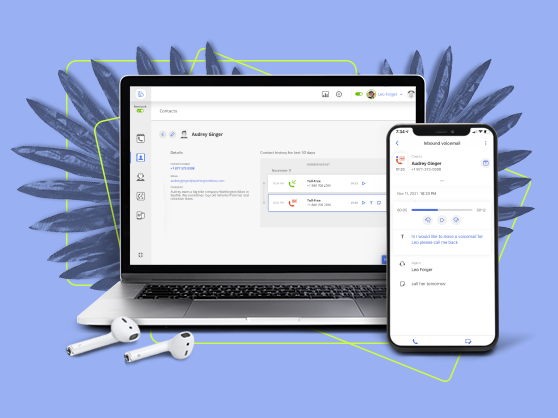Introduction
If someone calls your home during the day, they’re usually not too surprised if you don’t answer the phone — since most people work during the day. Consequently, when someone does call your home, he/she probably doesn’t mind leaving a voicemail and receiving a call from you later.
When people call a business, though, they expect someone to answer the phone — especially during normal business hours. Of course, there are times when voicemail may be helpful for businesses as well (such as when the office is closed.) Still, callers do prefer to speak to someone when they call.
Voicemail is relatively cheap (and even free with many systems.) But, there are many other costs associated with voicemail that you may never have considered. In this post, I will discuss some of these not-so-well-known — yet still very expensive — costs your business incurs every time a caller is sent to voicemail.
Lost Revenue
Of course, the most obvious cost of not answering your business phone is that of lost sales or revenue. I mean, if you miss a call, it may have been from a customer wanting to make another purchase from you or a potential customer looking to make his/her first one. How much revenue do you lose by not answering a call? Who knows? It’s very difficult to calculate. But, I think it’s safe to assume that any lost revenue affects your bottom line negatively.
When you do miss a call from a potential customer, it is quite possible that he/she will leave a voicemail message and request a callback. If you’re the only game in town for the product or service you provide, that caller may actually wait for a callback. However, if there are other companies in your area that provides the same goods or services, you can be pretty sure that the caller will be calling your competitors as soon as he/she hangs up the phone.
If you are able to call the customer/potential customer back right away, you may be able to salvage or close a deal. If you’re busy for a couple of hours, though, the customer may find what he/she needs from another vendor. If that happens, how costly is that voicemail then? Well, depending on the goods or services you provide, that missed call could cost you a bundle.
A Computer Weekly article cites data from a BT Business report that indicates small and medium sized companies are losing millions every year due to missed calls. The report states that, in the UK alone, SMEs are losing £90,000,000 (roughly $135,000,000 at the time of publication) due to missed calls. The BT Business report goes on to say that the cost average cost of a single missed call is £1,200, or about $1800.
The report also shows that 85% of callers who can’t reach company on the first try will not call back and that 75% will not leave a voicemail. Can your business afford these types of losses? I don’t think so.
BT Business sums it up best when talking about missed calls. In their article title “Fixed Mobile Convergence — Flash in the pan or the next big thing?”, the author states:
“So if you can’t be contacted on the phone at the first attempt then a potential customer probably won’t call back or leave a message. More likely they’ll simply move on to someone else who can meet their needs immediately. Being able to contact you the first time could be the difference between making a sale and losing a customer.”
Wasted Advertising/Marketing Funds
If yours is like most businesses, you probably spend a hefty sum on advertising and marketing. This is a natural, normal course for businesses to take. After all, what’s that old adage? You have to spend money to make money. Of course, the not-so-well-kept secret to advertising and marketing is to spend less than a campaign generates in sales revenue — Economics 101 and all that.
If you’re missing calls, and those callers aren’t calling back or leaving voicemails, then you are effectively throwing at least some of your advertising/marketing funds right out the window.
Let’s look at an example. Say, your company spends $10,000 on an advertising/marketing campaign that aims to attract 500 new and solid leads (Internet ads, print, radio, TV — it doesn’t matter which form.) Let’s also say that the product/service you’re promoting in the campaign costs $1500 and leaves you with an average profit of $375 (about 25%.) If you are able to covert 20 percent of those leads into customers, your business will see an initial gross profit of $27,500.
This breaks down to:
100 new customers (20% of 500 new leads)
100 x $375 (Number of new customers X Profit for each sale) = $37,500
Gross Profit ($37,500) — Advertising/Marketing Campaign Cost ($10,000) = $27,500
That’s not too bad a return on a $10,000 investment. Wouldn’t you agree? But, how much will missing calls from these leads cost you? Let’s take a look at a scenario that takes missed calls into consideration.
Your campaign generates the desired 500 new leads, and they all call your business for more information. But, you miss 20% of those calls because you’re too busy or for whatever other reason. The wasted costs and lost revenue are considerable.
The campaign costs $10,000 and generates 500 new leads. Therefore, the cost for each new lead is $20 ($10,000 ÷ 500 = $20).
For whatever reason, your business fails to answer calls from 20 percent of the new leads. This results in $2000 of pure waste right from the start (500 X .20 X $20). This $2000 loss is the amount of advertising/marketing funds you wasted because those 100 leads probably won’t ever call back.
However, the losses don’t stop there. If your conversion rate for the campaign is 20 percent, that means you lost 20 new customers as well, and that works out to another $7,500 hit (20 X $375). So, as you can see in this scenario, not being able to answer your phone would reduce your profit for the campaign by about $9,500. That’s a huge it.
It’s also important to note that the losses mentioned here are tiny when compared to the amount of revenue you’ll lose from new customers who may have later evolved into loyal, repeat buyers.
Lost Credibility
Lost revenue and marketing funds are bad enough, but the worst thing about letting too many calls go to voicemail is the loss of credibility that it causes for your company. When dealing with brands or companies, customers expect prompt, professional service and speedy replies to their inquiries.
If your staff or phone system is so overwhelmed that no one is available to answer the phone, this reflects very poorly on your business and its operation. While some consumers and SMBs are okay with making purchases from very small businesses, most prefer to deal with larger companies they consider to be stronger and more reliable.
Reliable companies answer the phone (even if they place the caller on hold for a while.) Sending callers to voicemail may indicate that your company is understaffed or worse — customer service is not a priority to your business.
How much is your company’s credibility and reputation worth? It’s incalculable; that’s how much. In today’s “customer-centric” marketplace, buyers have all the power it seems. Therefore, any hit to your business’s credibility can spell disaster.
You can always recoup financial losses through better planning and hard work. Once your company’s credibility is questioned or damaged, though, fixing it is much, much harder. The bottom line is modern consumers frown on companies that don’t answer the phone — so, don’t be one.
Reducing Unnecessary Voicemail Costs
By now, you should understand the importance of answering all incoming calls and avoiding voicemail use as much as possible. However, simply having someone available to answer the phone may not be enough; you also have to make sure that calls get to the right person on your team.
The best way to ensure that all calls get to the right person is to implement a telephone system that supports intelligent routing. Intelligent routing can be customized and configured to meet your specific calling needs and provides real, tangible benefits, such as:
- An all-for-one and one-for-all number — Many small business owners believe they need several phone numbers to provide that “large corporate” look and feel for their customers. Using a single number for all your departments/staff members is just as effective and much easier for your customers. A good phone system with intelligent routing enables you to provide prompts for your customers so they can choose the department/staff member with whom they wish to speak.
- Calls don’t go to waste — In a perfect world, you’d be able to answer every call that came in. But, as a business owner or manager, that’s just not possible. Running a business requires you to wear too many hats that consume too much time for you to be able to answer the phone always. Still, someone needs to attend to those important calls since you never know when a new customer is trying to reach you. With intelligent routing, you can choose to silence incoming calls and redirect them to another employee, an answering service or to voicemail (if during non-business hours.)
- VIP lists — Let’s face it; every business has a few customers it values more than others. Consequently, there are some VIP customers we want to hear from — no matter how busy we are with other tasks. A quality phone system enables you to create a “VIP” list and implement different routing rules for customers on the list. For instance, customers on a VIP list could be redirected to a recording with special promotion information or be placed on a fast track to reach you on the first try.
Intelligent routing can help reduce the number of callers who are sent to voicemail considerably. Nevertheless, there will be times when routing to voicemail is unavoidable. If you check and respond to your voicemails very quickly, you may be able to salvage and close a few more deals; but only if you call back quickly.
Your takeaway from this post should be minimizing your customers’ voicemail usage as much as possible by answering all incoming calls quickly and ensuring an intelligent routing system is in place when you cannot. If you cannot answer and a customer does have to leave a voicemail, make sure that you get back to the person as quickly as possible.
Finally, remember that every missed call costs you something. So, if you want your business to earn more and spend/lose less, don’t give customers an opportunity to shop somewhere else — answer that phone!






















